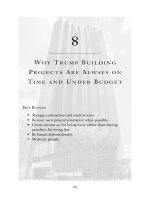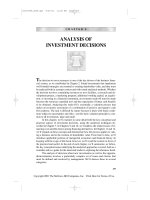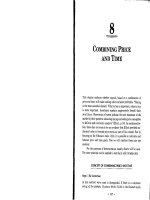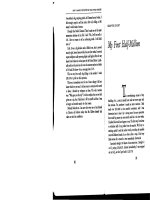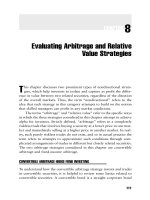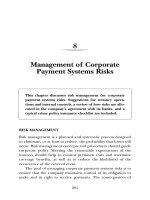Chapter 8 stock valuation
Bạn đang xem bản rút gọn của tài liệu. Xem và tải ngay bản đầy đủ của tài liệu tại đây (757.12 KB, 34 trang )
Chapter 8
Stock Valuation
McGraw-Hill/Irwin
Copyright © 2010 by The McGraw-Hill Companies, Inc. All rights reserved.
Key Concepts and Skills
•
Understand how stock prices depend on
future dividends and dividend growth
•
Be able to compute stock prices using the
dividend growth model
•
Understand how corporate directors are
elected
•
Understand how stock markets work
•
Understand how stock prices are quoted
8-2
Chapter Outline
•
Common Stock Valuation
•
Some Features of Common and
Preferred Stocks
•
The Stock Markets
8-3
Cash Flows for
Stockholders
•
If you buy a share of stock, you can
receive cash in two ways
–
The company pays dividends
–
You sell your shares, either to another investor in the market or back to the
company
•
As with bonds, the price of the stock
is the present value of these
expected cash flows
8-4
One-Period Example
•
Suppose you are thinking of purchasing
the stock of Moore Oil, Inc. You expect it
to pay a $2 dividend in one year, and you
believe that you can sell the stock for $14
at that time. If you require a return of 20%
on investments of this risk, what is the
maximum you would be willing to pay?
–
Compute the PV of the expected cash flows
–
Price = (14 + 2) / (1.2) = $13.33
–
Or FV = 16; I/Y = 20; N = 1; CPT PV = -13.33
8-5
Two-Period Example
•
Now, what if you decide to hold the
stock for two years? In addition to the
dividend in one year, you expect a
dividend of $2.10 in two years and a
stock price of $14.70 at the end of
year 2. Now how much would you be
willing to pay?
–
PV = 2 / (1.2) + (2.10 + 14.70) / (1.2)2 = 13.33
8-6
Three-Period Example
•
Finally, what if you decide to hold the
stock for three years? In addition to the
dividends at the end of years 1 and 2, you
expect to receive a dividend of $2.205 at
the end of year 3 and the stock price is
expected to be $15.435. Now how much
would you be willing to pay?
–
PV = 2 / 1.2 + 2.10 / (1.2)2 + (2.205 + 15.435) / (1.2)3 = 13.33
8-7
Developing The Model
•
You could continue to push back the
year in which you will sell the stock
•
You would find that the price of the
stock is really just the present value
of all expected future dividends
•
So, how can we estimate all future
dividend payments?
8-8
Estimating Dividends:
Special Cases
•
Constant dividend
–
The firm will pay a constant dividend forever
–
This is like preferred stock
–
The price is computed using the perpetuity formula
•
Constant dividend growth
–
The firm will increase the dividend by a constant percent every period
–
The price is computed using the growing perpetuity model
•
Supernormal growth
–
Dividend growth is not consistent initially, but settles down to constant growth eventually
–
The price is computed using a multistage model
8-9
Zero Growth
•
If dividends are expected at regular intervals
forever, then this is a perpetuity and the present
value of expected future dividends can be found
using the perpetuity formula
–
P
0
= D / R
•
Suppose stock is expected to pay a $0.50
dividend every quarter and the required return is
10% with quarterly compounding. What is the
price?
–
P
0
= .50 / (.1 / 4) = $20
8-10
Dividend Growth Model
•
Dividends are expected to grow at a
constant percent per period.
–
P
0
= D
1
/(1+R) + D
2
/(1+R)2 + D
3
/(1+R)3 + …
–
P
0
= D
0
(1+g)/(1+R) + D
0
(1+g)2/(1+R)2 + D
0
(1+g)3/(1+R)3 + …
•
With a little algebra and some series work,
this reduces to:
g-R
D
g-R
g)1(D
P
1
0
0
=
+
=
8-11
DGM – Example 1
•
Suppose Big D, Inc., just paid a dividend
of $0.50 per share. It is expected to
increase its dividend by 2% per year. If the
market requires a return of 15% on assets
of this risk, how much should the stock be
selling for?
•
P
0
= .50(1+.02) / (.15 - .02) = $3.92
8-12
DGM – Example 2
•
Suppose TB Pirates, Inc., is
expected to pay a $2 dividend in one
year. If the dividend is expected to
grow at 5% per year and the required
return is 20%, what is the price?
–
P
0
= 2 / (.2 - .05) = $13.33
–
Why isn’t the $2 in the numerator multiplied by (1.05) in this example?
8-13
Stock Price Sensitivity to
Dividend Growth, g
D
1
= $2; R = 20%
8-14
Stock Price Sensitivity to
Required Return, R
D
1
= $2; g = 5%
8-15
Example 8.3 Gordon Growth
Company - I
•
Gordon Growth Company is expected to
pay a dividend of $4 next period, and
dividends are expected to grow at 6% per
year. The required return is 16%.
•
What is the current price?
–
P
0
= 4 / (.16 - .06) = $40
–
Remember that we already have the dividend expected next year, so we don’t
multiply the dividend by 1+g
8-16
Example 8.3 – Gordon Growth
Company - II
•
What is the price expected to be in year 4?
–
P
4
= D
4
(1 + g) / (R – g) = D
5
/ (R – g)
–
P
4
= 4(1+.06)4 / (.16 - .06) = 50.50
•
What is the implied return given the change in price
during the four year period?
–
50.50 = 40(1+return)4; return = 6%
–
PV = -40; FV = 50.50; N = 4; CPT I/Y = 6%
•
The price is assumed to grow at the same rate as the
dividends
8-17
Nonconstant Growth
Problem Statement
•
Suppose a firm is expected to increase
dividends by 20% in one year and by 15%
in two years. After that, dividends will
increase at a rate of 5% per year
indefinitely. If the last dividend was $1 and
the required return is 20%, what is the
price of the stock?
•
Remember that we have to find the PV of
all expected future dividends.
8-18
Nonconstant Growth
Example Solution
•
Compute the dividends until growth levels off
–
D
1
= 1(1.2) = $1.20
–
D
2
= 1.20(1.15) = $1.38
–
D
3
= 1.38(1.05) = $1.449
•
Find the expected future price
–
P
2
= D
3
/ (R – g) = 1.449 / (.2 - .05) = 9.66
•
Find the present value of the expected future cash
flows
–
P
0
= 1.20 / (1.2) + (1.38 + 9.66) / (1.2)2 = 8.67
8-19
Quick Quiz – Part I
•
What is the value of a stock that is
expected to pay a constant dividend
of $2 per year if the required return is
15%?
•
What if the company starts increasing
dividends by 3% per year, beginning
with the next dividend? The required
return stays at 15%.
8-20
Using the DGM to Find R
•
Start with the DGM:
g
P
D
g
P
g)1(D
R
g-R
D
g - R
g)1(D
P
0
1
0
0
1
0
0
+=+
+
=
=
+
=
8-21
Finding the Required Return
- Example
•
Suppose a firm’s stock is selling for $10.50.
It just paid a $1 dividend, and dividends are
expected to grow at 5% per year. What is
the required return?
–
R = [1(1.05)/10.50] + .05 = 15%
•
What is the dividend yield?
–
1(1.05) / 10.50 = 10%
•
What is the capital gains yield?
–
g =5%
8-22
Table 8.1 - Stock Valuation
Summary
8-23
Features of Common Stock
•
Voting Rights
•
Proxy voting
•
Classes of stock
•
Other Rights
–
Share proportionally in declared dividends
–
Share proportionally in remaining assets during liquidation
–
Preemptive right – first shot at new stock issue to maintain proportional
ownership if desired
8-24
Dividend Characteristics
•
Dividends are not a liability of the firm until a
dividend has been declared by the Board
•
Consequently, a firm cannot go bankrupt for not
declaring dividends
•
Dividends and Taxes
–
Dividend payments are not considered a business expense; therefore, they are not tax
deductible
–
The taxation of dividends received by individuals depends on the holding period
–
Dividends received by corporations have a minimum 70% exclusion from taxable income
8-25


